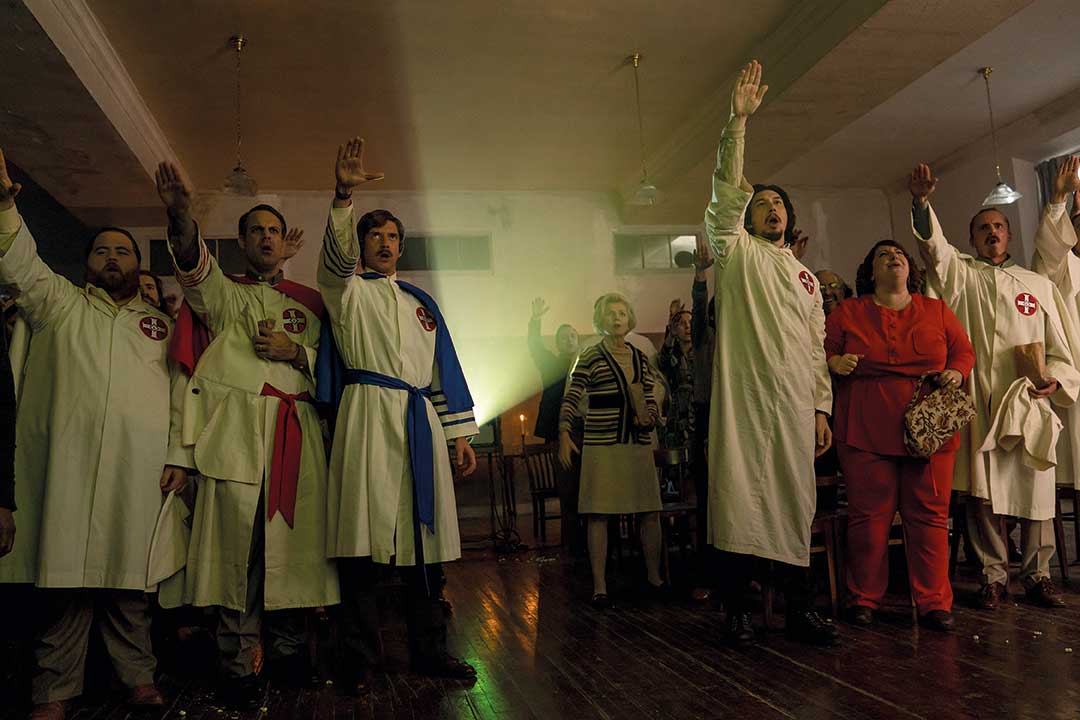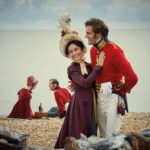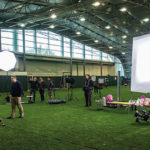
Lit Up!
Posted on Oct 31, 2018 by Julian Mitchell
Spike Lee’s Blackkklansman is the first major movie to arrive as a reaction to President Trump’s America. DOP Chayse Irvin talks through his part in its production
Words Madelyn Most
Very few American films were invited to the 2018 Cannes Festival, but Spike Lee’s latest ‘joint’, BlacKkKlansman, was a powerful exception that sent shockwaves through the audience. Lee’s first Cannes experience was in 1986 when he won the Prix de Jeunesse for She’s Gotta Have it, and his 1989 Do the Right Thing was nominated for the Palme d’Or but was mysteriously displaced by Steven Soderbergh’s debut film, Sex, Lies, and Videotape.
At the press conference for BlacKkKlansman, Spike Lee explained that Producer-Director Jordan Peele called him out of the blue to pitch the story of Ron Stallworth, the first African-American police officer and detective in the Colorado Springs Police Department who infiltrated the ranks of the KKK. The film would be based on Stallworth’s memoir, Black Klansman: Race, Hate and the Undercover Investigation of a Lifetime. “When my co-writer Kevin Willmott and I came on board, our job as storytellers was to take this story from the early 70s and connect it to the present day,” Spike says.
 Adam Driver as police officer Flip Zimmerman and John David Washington as Ron Stallworth.
Adam Driver as police officer Flip Zimmerman and John David Washington as Ron Stallworth.
Not having seen a film that blasted me out of my seat like this one did for a very long time, I hastily contacted cinematographer Chayse Irvin to ask him for 15 minutes to talk about his work. Reserved and somewhat private, he agreed to come up from Marseille to meet on a rooftop terrace overlooking the Croisette where I filmed the discussion that began at 13:14 and finished at 18:07. My assistant ran off with the camera to film the tapis rouge, and we ran off to Café Roma to cool our parched throats with Hoegaardens.
Chayse Irvin was born in Vancouver to an American mathematician father and a Canadian jazz singer and teacher mother. As a kid, Chayse and his ‘gifted’ brother made small films with their mom operating camera, and spent summers on a lakeside near Vancouver with their photographer/jazz musician uncle, absorbing movies from his eclectic collection. “These were defining moments,” he says. Their mother made sure they studied art, music, philosophy, painting, piano and harmonica, but Chayse admits he was more into basketball, while his brother built huge Lego sculptures, got into animation, and studied computer software. “I think there are two types of people in the world: ‘crickle’ people who are logical thinkers who can examine the minutiae, and ‘goo’ people who are abstract, spontaneous, free flowing. “My parents are exact opposites, me and my brother are too,” he adds.

At 16, Chayse entered a film program in high school that fast tracked him into Capilano University’s Film School, while he got set experience working on films with a Production Designer/Producer who mentored him. After graduating, Irvin worked as a grip before lighting and directing music videos. “I realised I learned a lot in Vancouver,” he says, but it was time to meet other directors, so Chayse left for L.A. and slept on couches for several years struggling to find work. Those early experiences were horrible, but with the arrival of Vimeo, young aspiring cinematographers finally had a platform where they could share their work, join a community and start making films together. Chayse photographed many low budget films before finally shooting commercials; reluctantly, because ‘Advertising is telling people to buy things’ and that clashed with his principles. He finally succumbed in order to meet new directors and experiment with new techniques.
Camerimage break
Chayse says his big break was shooting Medeas (2013) with director Andrea Palloaro, that won Camerimage’s Best Cinematography Debut. The same creative duo made Hannah, which premiered at the 2017 Venice Film Festival where Charlotte Rampling won the Best Actress Award, but it was probably Beyonce’s Lemonade that proclaimed his unique talent to the filmmaking world.
 Spike Lee on-set.
Spike Lee on-set.
“I’m very attached to European cinema and have done more European projects than American. BlacKkKlansman was my first American studio film. It was very American and much bigger than the European films I usually shoot. I had never met Spike before and my agent called me in Sweden to say Spike wanted to meet me. I took a detour from my next job in Capetown to his office at 40 Acres in Brooklyn.
“They handed me the wrong script to read, so I had only ten minutes to skim through BlacKkKlansman, which is not easy for someone as dyslexic as I am. It was hard to interpret the screenplay – whether it was a comedy or something very dark. Spike was anxious to get to the Yankees game where we sat behind the coaches. We got on really well,” he says. That might be because Spike’s Dad is a jazz musician, his mother and grandmother are teachers and educators, and Chayse’s parents are the same, in reverse. It is well known that Spike’s crews are like family; questioned about his choice of DOP at the press conference, Lee explained that neither his usual DPs, Matty Libatique or Ellen Kuras were available, so he wanted new blood and to work with a young cinematographer.
“But there was one caveat: Spike said he shoots two cameras all the time, and that was new for me,” continues Chayse. “I always work two cameras, but never simultaneously. I overlap them so we keep shooting, keep moving forward and not waste time. I talk to the operators on coms, whisper to them if they have to adjust the composition. I had no rapport with these New York camera operators, I never worked with them before, so I was a bit apprehensive, and I always operate the camera myself. I need to be challenged and have that control. Cinematography is like jazz to me: I know what I’m doing when I’m there responding to things. In jazz, it’s called ‘in the pocket‘ or ‘in the zone’. Operating the camera puts me in the pocket and I can get in that flow. I have to add that I really enjoyed working with both camera operators, Rick Sarmiento and Kerwin DeVonish.

“Actually, the film grew from within itself; the decision to shoot on 35mm film happened in the process of testing. Panavision has a plethora of different options, so I tested the Alexa XT, an Alexa Mini, the RED, the Dragon, ARRICAM LT and Panavision’s XL II. I tested anamorphic and spherical lenses. Panavision had some vintage Ultra speeds from the 70s. We tested different film stocks and I experimented with pre-flashing the negative and looked at the images in the DI suite. The final package was four cameras: two Panavision Millennium XLII cameras from Panavision NY, my own Arricam LT, andan Aaton Penelope that was shipped in from Sweden. Nothing can rival the Penelope for handholding inside cars because it’s so compact and well designed. Panavision NY adapted my own Arricam LT so I could shoot both Panavision and Zeiss lenses, and we used the older lenses that were challenging for the assistants. In pre-production, I was testing different formats, but I hadn’t really thought shooting on film was feasible but then, all this serendipity happened. The cameras were right, the lenses looked right, Kodak Lab had just opened in NY and they loved the project and wanted to support it. It was one of their first productions and they did a fantastic job.
“I like mixing formats and aspect ratios, experimenting with different things and messing up the image – like skat jazz, which is random notes, energy, all mixed up. The opening scene with Alec Baldwin starts off as a 16mm black & white sequence, then switches to 35mm Ektachrome for the The Birth of a Nation sequence. MOMA, the Museum of Modern Art in NYC, send us a tinted print copy of the movie, The Birth of A Nation which I then photographed on Ektachrome stock that someone found in a garage. The colours came out in strange and interesting intense hues of red and blue.

“We shot the film in New York, but scouted in Colorado Springs, where the real story took place, and shot a lot of B roll there. Spike and I just fed off each other, we just jived. At the beginning, we planned things out together and I did lots of zooming, but basically, he gave me a lot of freedom to do what I wanted. In the studio, however, Spike would get there very early each morning and work everything out exactly how he wanted. Spike let the film grow organically. We couldn’t rent the studio until we were ready to shoot, so we only saw the actors on the sets with the lighting, cameras and crew for the first time when we walked on the stage. You have to respond spontaneously and flow with it. Spike’s team is like a family, everyone on set is an artist, and there was a process there. I learned a lot from Spike.”
Organic growth
Portions of the film might seem predictable, but the ending is what makes this film brilliant. It comes out of nowhere, obviously it wasn’t in the script. That is Spike’s genius, he knows exactly what the audience feels and will react to. Some artists are ahead of their time, Spike sees things in time.”
“We had a tight workflow: Kodak took the negative and processed it, then Kodak shipped it to Company 3 to scan the film. I have a close relationship with my finishing colourist, Tom Poole, and he sends me a colour image. At the beginning I watched dailies, but studios have strict systems to protect their footage from piracy. The images on the online links were so highly compressed that I stopped watching and just relied on my colourist and my stills. I am accustomed to not seeing my work; before this film, I was in Sierra Leone and never saw dailies. I give that trust to my technicians. I have a close collaboration with Tom Poole and we came up with look together, he made a LUT. Tom defends the integrity of my original intention for the image. It is really important to work with people you trust, otherwise strange things can happen to your photography.”

“Spike watched the film in the DI suite and with a laser light would point to a corner and say “Paint that out!” but other than that, he was really happy and loved what was going on.”
It was Focus Features who paid for the movie to be Dolby ‘Visionized’. Dolby designed this HDR technology to enhance the viewing experience by intensifying the colours and creating a million to one contrast ratio. The projection screens are twice the brightness of standard screens and the projectors are “powered by dual-laser projection technology engineered for a consistent experience” according to Dolby Vision HDR trademark.
It makes brighter whites, deeper shadows, richer blacks and an enhanced rendition of the image, but, continues Chayse, “You have to colour grade it with a special projector to get the correct tones and colours that no other projector can match. There are only certain theatres that have this technology and it’s advertised as a superior film experience, so ticket prices are higher, but it does project a magnificent image. I saw The Revenant in Dolby Vision and I hope to work with them again. As a cinematographer, my goal is to make images that are hypnotic and I don’t necessarily know how to do that, but my approach to any project is a Daoist one – to allow things to come up from within itself naturally. It’s important to treat the audience with respect and let them interpret the film. I believe the role of the cinematographer and the filmmaker is to pose questions, not answer them. To me, that’s Art.”

Watching Saturday night closing ceremonies on a screen across from the Palais at Cannes, I shouted out loud when Jury President Cate Blanchett announced BlacKkKlansman as winner of the Grand Prix, which is the second prize after the Palme d’Or. An overjoyed Lee jumped up on stage, hugging his longtime editor Barry Brown, called up Adam Driver and Laura Harrier and thanked everyone. He said, “Like in that film we all remember not long ago, this year we are in the year of living dangerously and I’d like to dedicate this prize to the People’s Republic of Brooklyn.”
Barry Alexander Brown – Editor
Oscar nominee and longtime collaborator with Spike Lee, starting with She’s Gotta Have It. The split screen sequences from BlacKkKlansman which culminate in a horrific racially-motivated act of violence show Barry’s eye is working like a DOP’s. He did a great job working with Spike to keep the story on track (there’s a lot of moving parts) and also it’s one of those true stories so you know the ending but you’re still on the edge of your seat as to whether or not the cops and their ruse will be found out – by the KKK no less.
Curt Beech – Production Designer
“There are at least three different but related worlds in BlacKkKlansman – the police, the KKK and the black student activists. The sets reflect that – Ron Stallworth is hip and young and progressive but it’s still a police department – hello wood paneling. It’s not been updated since the 50s most likely – it’s sturdy but in need of some renovation and change, like their world itself. The local KKK leader Felix – his world is stagnated, stuck in the past and his dwelling reflects that. It’s worth noting that the KKK live in plain sight and so, for instance, their living room is well appointed and lovely while the garage is full of the sinister and lethal.”








